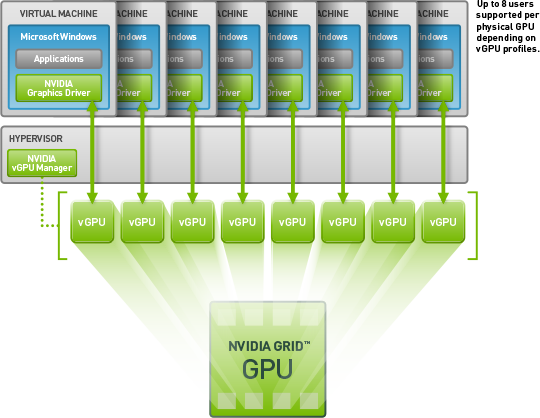Look at what's virtual now: 3D graphics via GPUs


Graphics acceleration was a hot topic at this year's Citrix Synergy conference for virtualization, mobility, networking and cloud solutions.
That's because customers like Bell Helicopter, City of Waukesha, Drake University and PSA Peugeot shared stories of improved mobility, scalability and employee productivity due to NVIDIA GRID graphics acceleration for virtual desktop infrastructure (VDI).
Alphonse Karr once said, "The more things change, the more they are the same."
Too bad Alphonse, and I feel like I can call him Alphonse, didn't know about virtualization. He wouldn't have been so keen on that statement. Perhaps he'd been just another blogger voice among the din. You've probably read a few of my anti-VDI rants that describe poor performance from so-called traditional VDI implementations, but NVIDIA just might have a solution for your graphics-intensive virtual desktop user types: the virtual GPU.
Traditional VDI relies on host server CPU for graphics capability. That imposes a lot of limitations for virtual desktops that need graphics acceleration for applications. Because of those limitations, it's almost impossible to get a satisfactory user experience from virtualized, interactive, and media-rich applications. For task workers, knowledge workers, and those who work with text-based applications, virtualization (VDI) works pretty well. However, their counterparts who use heavier graphics-intensive programs, VDI is a fail.
Benefits of NVIDIA GRID for IT:
- Leverage industry-leading virtualization solutions, including Citrix, Microsoft and VMware
- Ability to add your most graphics-intensive users to your virtual solutions
- Improved the productivity and mobility for all of your users
- Enhanced data and IP security for models and assets
Benefits of NVIDIA GRID for users:
- Access to all critical applications, including the most 3D-intensive
- Highly responsive, rich multimedia experiences
- Access from anywhere, on any device
Graphics designers, video editors, video producers, and developers often complain about VDI performance, but by offloading graphics processing from the CPU to the GPU these users enjoy a richer, high performance experience.
NVIDIA GRID™ vGPU™ brings the full benefit of NVIDIA hardware-accelerated graphics to virtualized solutions. This technology provides exceptional graphics performance for virtual desktops equivalent to local PCs when sharing a GPU among multiple users.
GRID vGPU is the industry's most advanced technology for sharing true GPU hardware acceleration between multiple virtual desktops--without compromising the graphics experience. Application features and compatibility are exactly the same as they would be at the user's desk.
With GRID vGPU technology, the graphics commands of each virtual machine are passed directly to the GPU, without translation by the hypervisor. This allows the GPU hardware to be time-sliced to deliver the ultimate in shared virtualized graphics performance.
At Citrix Synergy, Dell, Citrix, and NVIDIA showed everyone how easy it is to setup VDI with NVIDIA GRID technology with the "#60in60 Challenge". Four small teams; one from Dell, one from NVIDIA, and two groups from Citrix raced to setup 60 Citrix XenDesktop with NVIDIA GRID vGPU-powered virtual desktops.
Each team had 60 minutes, using off-the-shelf hardware and software. After three rounds, over the course of three days, all four teams finished within minutes of each other. NVIDIA's team achieved the fastest time (Surprise?) in creating 60 virtual desktops in 53 minutes.
NVIDIA GRID looks impressive and I'm all for anything that can improve the performance of ill-fated VDI implementations. I haven't seen any direct performance enhancement numbers yet as to the percent of increase, but for workers who use graphics-intensive applications, oftentimes their perception of a performance increase surpasses any numbers generated by benchmark programs. The increases have been impressive enough for companies such as Bell Helicopter and PSA Peugeot to take notice.
But I wonder, even with the boost in graphics performance for GPU over CPU, do those same workers still suffer from disk access lag? I forgot to ask that question when speaking with NVIDIA, but it's a good question to ask. Graphics performance and disk access are the two big bottlenecks for any VDI implementation, even after upgrading to a gigabit Ethernet network.
If you'd like to see how GRID can work for you, there's a downloadable deployment guide available that will teach you how it's done.